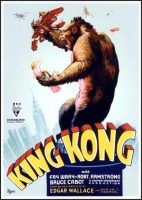King Kong movie storyline. Actress Ann Darrow (Fay Wray) and director Carl Denham (Robert Armstrong) travel to the Indian Ocean to do location shoots for Denham’s new jungle picture. Along the way, the actress meets and falls for rugged First Mate John Driscoll (Bruce Cabot). Upon arriving at a mysterious island, Ann is taken hostage by natives who prepare her as a sacrifice to the enormous ape Kong who rules over their jungle. But when Ann is rescued and Kong is captured, the real trouble begins.
The greatest and most famous classic adventure-fantasy (and part-horror) film of all time is King Kong (1933). Co-producers and directors Merian C. Cooper and Ernest B. Schoedsack (both real-life adventurers and film documentarians) conceived of the low-budget story of a beautiful, plucky blonde woman (Fay Wray) and a frightening, gigantic, 50 foot ape-monster as a metaphoric re-telling of the archetypal Beauty and the Beast fable. [Fay Wray mistakenly believed that her RKO film co-star, ‘the tallest, darkest leading man in Hollywood,’ would be Cary Grant rather than the beast. Later in her life, she titled her autobiography “On the Other Hand” in memory of her squirming in Kong’s grip.]
The major themes of the film include the struggle for survival on the primitive, fog-enshrouded, tropical Skull Island between the ardent and energetic filmmakers (led by Robert Armstrong), the hero (Bruce Cabot in a part originally offered to Joel McCrea), the voodoo natives, and the forces of nature (the unique Beast creature); unrequited love and the frustration and repression of violent sexual desires. However, the primitive, giant ape must also struggle against the forces of urban civilization and technology when it is exploited for profit and returned for display in New York City during a time of economic oppression.
From the start of the picture, its clever screenplay by James Ashmore Creelman and Ruth Rose (based on a story by Merian C. Cooper and Edgar Wallace) suggested the coming terror. The film was shot during the spring and summer of 1932 in the confines of the studio. Due to their limited budget for sets, Cooper and Schoedsack used the jungle locale from the latter’s previous film The Most Dangerous Game (1932) – an adventure film that also starred Fay Wray. When released, it broke all previous box-office records. Its massive, money-making success helped to save RKO Studios from bankruptcy.
King Kong (1933)
Directed by: Merian C. Cooper, Ernest B. Schoedsack
Starring: Fay Wray, Robert Armstrong, Bruce Cabot, Frank Reicher, Sam Hardy, Noble Johnson, Steve Clemente, James Flavin, King Kong, James Adamson, Walter Ackerman, Van Alder, Etta Mae Allen
Screenplay by: James Ashmore Creelman, Ruth Rose
Production Design by: Carroll Clark
Cinematography by: Edward Linden, J.O. Taylor, Vernon L. Walker, Kenneth Peach
Film Editing by: Ted Cheesman
Costume Design by: Walter Plunkett
Set Decoration by: Thomas Little, Ray Moyer
Art Direction by: Carroll Clark, Alfred Herman
Music by: Max Steiner
Distributed by: RKO Radio Pictures
Release Date: April 7, 1933
Views: 167

